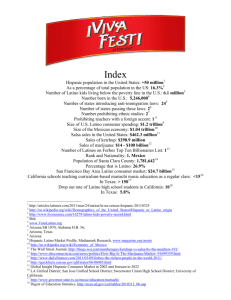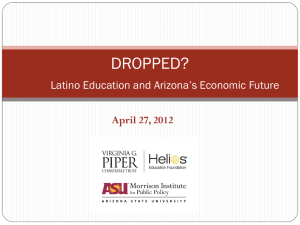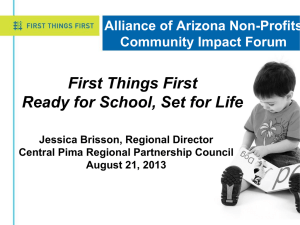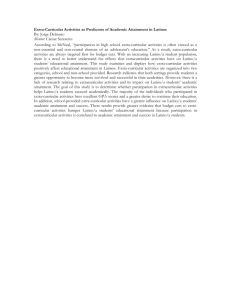Improving Access to Baccalaureates
advertisement
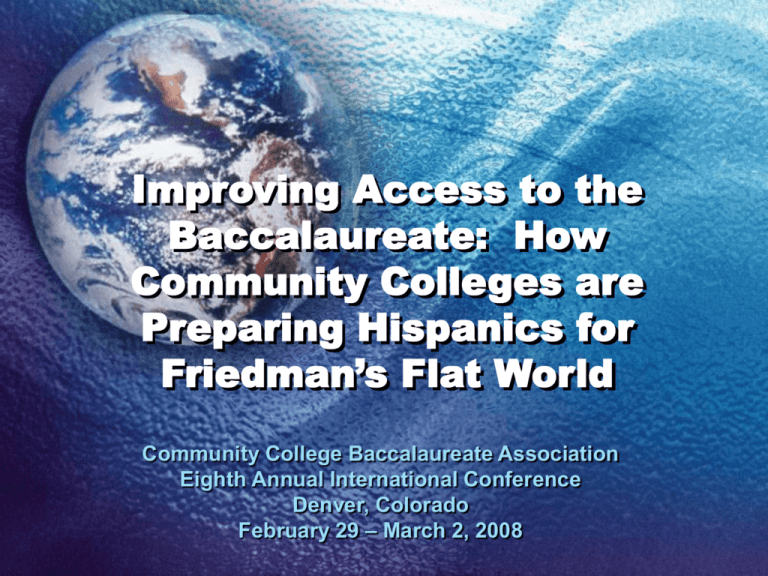
Improving Access to the Baccalaureate: How Community Colleges are Preparing Hispanics for Friedman’s Flat World Community College Baccalaureate Association Eighth Annual International Conference Denver, Colorado February 29 – March 2, 2008 Presenters • Roy Flores, Ph. D. – Chancellor, Pima Community College District, Tucson, Arizona royflores@pima.edu • Leila Gonzalez Sullivan, Ed. D. – W. Dallas Herring Professor, North Carolina State University, Raleigh, NC lgsullivan@ncsu.edu Agenda 1. The Flat World 2. Latinos in the United States 3. The New Workforce 4. Latino Educational Attainment 5. Promoting the Baccalaureate 6. Ensuring Equity 7. Policy Implications The Flat World Friedman’s Triple Convergence: 1. Global, web-enabled platform for multiple forms of collaboration 2. Horizontal networking for value creation 3. Three billion new players in developing world (China, India, former Soviet Union) Friedman, T. L. (2006). The world is flat: A brief history of the twenty-first century, updated and expanded. New York: Farrar, Strauss & Giroux. Latinos in the United States The New Diversity Source: U. S. Census Bureau Latino Migration Top 10 Growth States: 1990-2004 No Carolina Arkansas Georgia Tennessee So Carolina Nevada Alabama Kentucky Minnesota Nebraska 568% 504% 444% 406% 324% 318% 297% 248% 230% 223% Source: Tomas Rivera Policy Institute Analysis of US Census Data 2004 U. S. Latino Buying Power • $212 billion in 1990 • $847 billion in 2007 • $1.2 trillion in 2011 Source: Selig Center, University of Georgia The New Workforce The New Workforce White White 4.7 10.9 10.9 Black 11.8 Black 23.7 Hispanic 73.1 53.4 Hispanic 14.1 Asian/ Other Percent distribution, 2000 Source: Monthly Labor Review, May 2002 Asian/ Other Percent distribution, 2050 ‘Hot’ Occupations Job Skills High Skilled & Unskilled Jobs as a % of the Workforce, 2000 to 2012 2000 25% 20% 18.4% 19.2% 2002 20.7% 2012 13.0% 15% 11.8% 10.9% 10% 5% 0% Professional & related occupations Source: Bureau of Labor Statistics Production, installation, maintenance & repair occupations Education Required Projected Growth in Supply and Demand of Workers With Some Postsecondary Education, 1998 to 2028 Jobs requiring some postsecondary experience Workers with some postsecondary experience 150,000 140,000 Thousands 130,000 120,000 110,000 100,000 90,000 80,000 70,000 60,000 1998 2008 2018 2028 Sources: Bureau of Labor Statistics, U.S. Census Bureau and National Alliance of Business The College Premium Latino Earnings Source: Bureau of Labor Statistics, Highlights of Women’s Earnings, 2006 Latino Educational Attainment NAEP by Race, Ethnicity 8th Grade Math 2003 100% 90% 80% 70% 60% 50% 40% 30% 20% 10% 0% 7 32 61 11 16 36 36 53 42 38 Prof/Adv Basic 43 35 21 23 Below Basic 46 Black Latino Native White Asian Source: USDOE, NCES, National Assessment of Educational Progress (NAEP). Slide courtesy of The Education Trust. Average Scale Score Gaps Narrow, Then Mostly Widen NAEP Reading, 17 Year-Olds 300 280 260 240 220 200 African American Latino White Source: US Department of Education, National Center for Education Statistics. NAEP 1999 Trends in Academic Progress (p. 107). Slide courtesy of The Education Trust. Percent of High School Graduates Minority High School Graduates Less Likely to Have Completed Advanced Math and Science Courses 75% 56% 47% 50% 61% 64% 43% 29% 31% 32% 25% 0% Math American Indian Science Latino African American White Source: U.S. Department of Education, NCES, Condition of Education 2004, p 148. Data from 2000 NAEP High School Transcript Study. Slide courtesy of the Education Trust. Latino Educational Attainment Of 100 9th graders, how many… 80 70 75 Graduate HS in 4 years 60 50 40 53 49 48 Enter college right after HS 30 20 23 27 27 10 9 0 Whites 10 Finish college within 150% of program time African Hispanics Americans Source: National Center for Public Policy and Higher Education, November 2005 Educational Attainment of Arizona Population Age 25-34 Indexed to Most Educated Country Percent with a Bachelor’s Degree or Higher – By Gender and Race/Ethnicity 1.8 Percent with an Associates Degree or Higher – By Gender and Race/Ethnicity 1.4 1.6 1.2 1.4 1.0 1.2 1.0 0.8 Top Country (Norway) Top Country (Canada) 0.8 U.S. Index = 0.86 U.S. Index = 0.77 0.6 0.6 0.4 0.4 0.2 0.2 0.0 0.0 White Males Females African-American Hispanic/Latino Native American/AK Native Asian/Pacific Islander Males Males Males Males Females Females Females Females Source: U.S. Census Bureau, Public Use Microdata Samples (based on 2000 Census) and OECD Educational Attainment and Rank Among States—Arizona, 2005 (Percent) Age 18-24 with High School Diploma 77.7 42nd Age 25-64 with High School Diploma 84.2 41st Age 25-64 with Associate Degree 9.0 Age 25-64 with Bachelor's or Higher 26.3 Age 25-64 with Graduate/Prof. Degree 19th 35th 24th 9.2 50 40 30 Source: U.S. Census Bureau, 2005 American Community Survey 20 10 0 Latinos in College Students enrolled in degree granting colleges & universities, Fall 2004 17,272,000 – Hispanics: 1.8 million (10.5%) Degree-seeking students enrolled in public community colleges, Fall 2004 3,879,100 – Hispanics: 972,400 • 14.8% of all community college students • 53% of all Latinos in Source: NCES HEGIS Report, September 2005 higher education Latino Degree Attainment High School 52-63% Certificate 5.0% Associate’s 8.2% Bachelor’s 15.1% Source: NCES, National Educational Longitudinal Study 1988/2000. Graduate/ Professional 2.5% Percent Educational Attainment of Population Age 25-64 By Race/Ethnicity—Arizona, 2000 45.2 35 32.1 30.2 30 30.2 25.1 25 22.7 White African Am. 31.5 Hispanic/Latino Native American 24.1 23.3 20.3 20 18.3 14.9 15 10 13.0 7.9 10.4 9.6 8.6 6.1 4.5 5 5.7 5.9 5.2 3.0 2.2 0 Less than HS High School Source: U.S. Census Bureau, 2000 Census Some College Associate Bachelor's Graduate/Prof. Additional Bachelor’s Degrees Needed to Meet U.S. Average, Top Country, and Top State Arizona’s Current Population Age 25-44 with a Bachelor’s Degree or Higher 408,522 Additional Bachelor’s Degrees Needed to Meet: U.S. Average 78,987 Top Country (Norway) 156,134 Top State (Massachusetts) 285,808 The Bottom Line • Arizona is behind U.S.—And global competitor countries— in baccalaureate attainment levels of its adult population. • It is falling further behind. • Pima County residents attend Board of Regents universities at rates lower than residents of Coconino and Maricopa counties. • Increased educational attainment levels will depend heavily on improving graduation rates of Hispanics. • There is evidence of unmet need for accessible and affordable baccalaureate opportunities in Pima County. (continued) Promoting the Baccalaureate: Arizona Models Program for Joint Admission and Registration University of Arizona – Pima Community College • Response to changing educational needs of Pima County population. • Top 25% of the Pima County graduating high school classes can participate • Students admitted to UA while only attending Fall classes at PCC • Students may take up to 6 credits per semester at the University starting with the Spring semester • Each cohort approximately 50 students Benefits of Participation in PJAE • No need to reapply when ready to take all classes at UA. They are UA students even when only taking classes at PCC • Access to PJAE advisors and financial aid staff at UA and PCC • Can purchase a UA CatCard and a PCC ID card with all associated benefits • Use of the UA Campus Recreation facility for a fee • Ability to apply for Student Housing at UA Institutional Benefits – UA & PCC • Joint marketing and public information efforts • Joint faculty appointments • PCC faculty understand UA curriculum and connect with UA faculty • Assist all PCC students in transition to the University. • Improve retention rate of UA students • Increase number of students progressing toward baccalaureate Bachelor of General Studies Indiana University and PCC • 120 credit hours; complete 90 credits at PCC with lower tuition rates • After receiving Associate’s degree (60 credits), student applies to Indiana University. • Complete 30 credits at Indiana University, School of Continuing Studies, at in-state tuition rates • Stay in Tucson and complete the bachelor’s degree via distance education Raytheon Scholars Program Cooperative Program with: • Raytheon Missile Systems – Headquartered in Tucson, Arizona – 11,000 employees – 2004 Sales: $3.8 billion – World’s largest developer, producer and integrator of weapons systems • Pima Community College • University of Arizona Ensuring Equity Latinos and College Choice • Factors that affect college choice: – Socioeconomic status – Prior academic achievement – Degree objective – State in which one lives – Other: • • • • Limited information about options Limited financial resources Proximity to family and community Other Latinos/as attending (cultural connection) Source: New Directions in Community Colleges, no. 133, Spring 2006 Risk Factors • Delayed entry • Enrolled part-time • Work full-time • Have dependents • Single parent • No high school diploma • Financially independent • Poverty Sources: U. S. Dept. of Education National Center for Education Statistics, 1995-1996 National Postsecondary Student Aid Study; Community College Survey of Student Engagement. Components of Equity • College Preparation • Access • Academic Success, Goal Achievement HOW CAN WE PROMOTE EQUITY FOR HISPANICS? Source: Defending the Community College Agenda, Bailey and Smith Morest, 2006 Ensuring Equity • College preparation – Educational continuum: K-12 to community colleges to universities – Pre-college programs, targeted preparation programs – TRIO; counseling – Financial aid workshops • Access – Open door at community colleges – Developmental education, ESL – Dual admissions programs, AP courses Ensuring Equity • Academic success – Degree commitment – Intensity of attendance – Engagement with faculty, college – Student success courses – Welcoming climate, diverse campus – Mentoring – Transfer support on path to baccalaureate – Celebrations of culture, diversity Policy Implications • Pre K-16 and beyond: pathways & transitions • College knowledge • Financial assistance & expanded access • State funding • Emphasis on minorities in STEM • Articulation & transfer • Immigration reform, DREAM Act royflores@pima.edu lgsullivan@ncsu.edu

